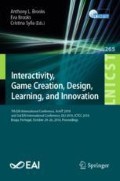Abstract
As an emerging technological and communication form of this century, digital and social media applications are gaining acceptance as platforms for creativity and inspiration in fine arts and graphic design. However, despite the proliferation of social media platforms and digital manipulation and painting apps, repurposing them for pedagogical purposes is yet to be explored as an educational strategy in the traditional painting studio or computer graphics classroom. The essence of this paper is to employ qualitative as well as quantitative research methods to explore the capabilities of digital and social media applications as a technological apparatus for creativity and expressivity in art and design education and practice. The research involves an empirical investigation of the potential offered by digital media applications and social media platforms to enhance the creative learning experience in art and design. The methodological procedures that are discussed in this paper are the result of two experimental studies; the first study explores the use of a digital painting technique – Phone Art– in the fine arts studio, while the second study investigates the use of social media applications in the graphic design classroom. The investigation is undertaken in an experimental educational setting in an attempt to determine how technology can be utilized by educators in order to optimize the creative performance of students.
Access this chapter
Tax calculation will be finalised at checkout
Purchases are for personal use only
References
Annum, G.: Digital painting evolution: a multimedia technological platform for expressivity in fine art painting. J. Fine Stud. Art 4(1), 1–8 (2014)
Chai, J., Fan, K.: Constructing creativity: social media and creative expression in design education. Eurasia J. Math. Sci. Technol. Educ. 14(1), 33–43 (2018)
Gentes, A., Valentin, F., Brulé, E.: Mood Boards as a Tool for the “In-Discipline” of Design. Brisbane, Australia (2015)
Gross, M.D.: Do EY-L Ambiguous intentions—a paper-like interface for creative design. In: Proceedings of Ninth Annual Symposium for User Interface Software and Technology, pp. 183–192 (1996)
Helmick, R.: Virtues of verisimilitude in design and art. Comput. Graph. 19(4), 505–507 (1995). http://wiki.commres.org/pds/Project_7eNrf2010/Virtues%20of%20verisimilitude%20in%20design%20and%20art.pdf. Accessed 19 Dec 2018
Igarashi, T.: Supportive interfaces for creative visual thinking. In: Collective Creativity Workshop, Nara, Japan (2000)
Kim, J., Agrawala, M., Bernstein, M.S.: Mosaic: designing online creative communities for sharing works-in-progress computer supported cooperative work (CSCW), pp. 246–258 (2017)
Langefels, E.: Millennial Women’s Use and Perception of Pinterest. University of Minnesota, Minnesota (2016)
Lee, Y.C.: m-Brand loyalty and post-adoption variations for the mobile data; services: gender differences. Comput. Hum. Behav. 27, 2364–2371 (2011)
Linder, R., Snodgrass, C., Kerne, A.: Everyday Ideation: All of my ideas are on Pinterest. Toronto, Canada (2014). http://dx.doi.org/10.1145.25556288.2557273. Accessed 12 May 2018
Sheldon, P., Bryant, K.: Instagram: motives for its use and relationship to narcissism and contextual age. Comput. Hum. Behav. 58, 89–97 (2016)
Smith, B.R.: Beyond computer art. In: Computer Art in Context, Leonardo Supplemental Issue, pp. 39–41 (1989). Journal of the International Society for the Arts, Sciences and Technology
Tiryakioglu, F., Erzurum, F.: Use of social networks as an educational tool. Contemp. Educ. Technol. 2(2), 135–150 (2011)
Wallas, G.: The Art of Thought. London, Johnathan Cape (1926). (Republished in 1931)
Author information
Authors and Affiliations
Corresponding author
Editor information
Editors and Affiliations
Rights and permissions
Copyright information
© 2019 ICST Institute for Computer Sciences, Social Informatics and Telecommunications Engineering
About this paper
Cite this paper
Al Hashimi, S., Zaki, Y., Al Muwali, A., Mahdi, N. (2019). Infusing Creativity and Technology Through Repurposing Existing Digital Tools and Social Media Apps for Educational Purposes. In: Brooks, A., Brooks, E., Sylla, C. (eds) Interactivity, Game Creation, Design, Learning, and Innovation. ArtsIT DLI 2018 2018. Lecture Notes of the Institute for Computer Sciences, Social Informatics and Telecommunications Engineering, vol 265. Springer, Cham. https://doi.org/10.1007/978-3-030-06134-0_36
Download citation
DOI: https://doi.org/10.1007/978-3-030-06134-0_36
Published:
Publisher Name: Springer, Cham
Print ISBN: 978-3-030-06133-3
Online ISBN: 978-3-030-06134-0
eBook Packages: Computer ScienceComputer Science (R0)

